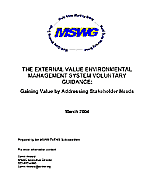The External Value Environmental Management System Voluntary Guidance: Gaining Value by Addressing Stakeholder Needs

The External Value Environmental Management System Voluntary Guidance: Gaining Value by Addressing Stakeholder Needs
In an effort to make EMSs more useful to businesses, environmentalists, decision makers, and the public, the Multi-State Working Group on Environmental Performance (MSWG) has released The External Value Environmental Management System Voluntary Guidance: Gaining Value by Addressing Stakeholder Needs. “EMS users need help showing people outside their organization what they’re accomplishing and how they are addressing environmental concerns, noted Bob Minicucci, the MSWG EVEMS Task Team Chair and EMS Coordinator at New Hampshire’s Department of Environmental Services. We hope this guidance document will help improve communication between corporations, government agencies, insurance companies, neighbors and other stakeholders so we can find more win-win solutions that protect the environment without harming the economy. This new Guidance document offers advice to those organizations that want to develop a management system that delivers measurable and reliable value to external audiences, such as government authorities, local communities, customers and suppliers, environmental groups, investors and the financial community, among others.” Historically, nongovernmental organizations have been somewhat skeptical about the value of EMSs for environmental protection, but now finally there’s something out there that defines high-performing EMSs that NGOs can get really excited about.” says Jason Morrison of the Pacific Institute who served on the drafting committee for the Guidance. The Guidance document focuses on three key elements of successful EMS: Achievement and demonstration of legal compliance involvement of external stakeholders, external communications, transparency and reporting. The Guidance document describes why including such elements in an EMS will build credibility with external stakeholders, and provides practical advice on how these particular elements can be designed and implemented to deliver the desired outcomes. This Guidance is intended for any organization that is putting an EMS into place that seeks to address the expectations of, and secure the confidence of, external audiences. The Guidance was produced by a team that included representatives from across the sectors represented within MSWG. Over 20 persons from these different sectors contributed to the drafting of the text of the Guidance document, and the text was regularly vetted through the broader membership of MSWG via its consensus-driven process. The Guidance is not a policy statement of, nor does it express any agreements or requirements made by, any of the employers of MSWG members, specifically including the United States Environmental Protection Agency or any of the individual states. Rather, it represents the consensus views and professional judgment of the wide array of viewpoints and expertise convened by MSWG. MSWG is a state-driven organization that convenes governmental, non-governmental, business and academic perspectives and skills to conduct research, promote dialogue, create networks and establish partnerships that improve the state of the environment, economy and community through systems-based public and private policy innovation. Overview

